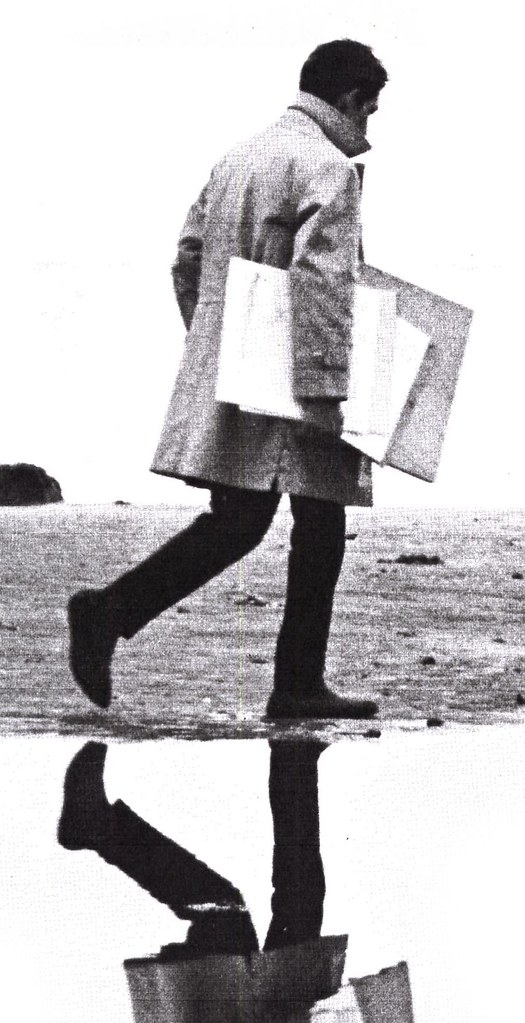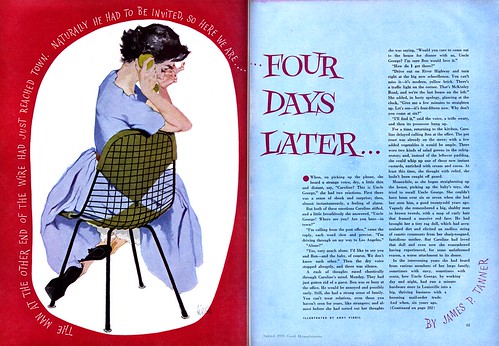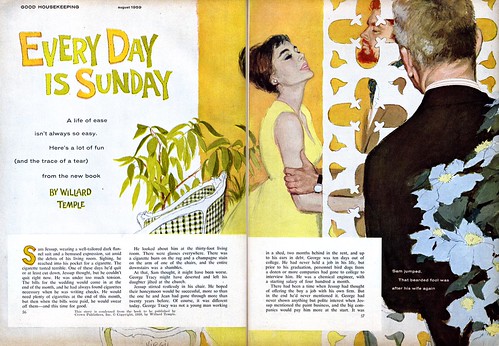
"I still remember him that rainy autumn day in New York City," she writes today, "looking like a skinny drowned rat with a black portfolio almost as heavy as he was."
Anita continues:
The year was 1952 and, though I was the Costume Researcher at Rahl Studios, I was manning the lunchtime reception desk when Andy walked in.

I was 21 at the time, a graduate with honors from New York's High School of Music & Art, and recipient of a scholarship to The Art Students’ League. I had already worked right out of high school as an assistant to the Art Director of Town & Country Magazine. That was Souren Ermoyan, but in a couple of months, he left to become Art Director for Good Housekeeping Magazine. His assistant, Tony Mazzola, took over. (Tony later became Editor of T&C and then moved on to become Editor of Harper’s Bazaar for decades.) So it was that the two of us became the Art Department. I worked alone with Tony the rest of my time there before taking the job later on at Rahl Studios, New York's second largest art studio. Cooper Studios being top dog.
This soft-spoken shy individual gave me his name, Andy Calafatello, and said he had an appointment and I announced him by phone to Rahl. Patiently, he sat and waited opposite me on the couch at 551 Fifth Avenue (which was the Fred French Building, memorable for its huge and ornate double brass doors).
The door to Rahl’s office was shut. All was quiet. And when it finally opened, a burly attractive dark-haired man with a crew cut and the Madison Avenue Brooks Brothers attire, came out and ushered Andy and his huge wet portfolio into his office. A little later, Rahl’s right-hand man, Willard Seymour, joined them.
A long time ensued behind the closed door. The life of the studio picked up as the illustrators trickled back in from lunch. When the young man emerged from the meeting with Phil Rahl and Willard Seymour, he was a member of that studio. It was at that time they suggested he use his middle name, Virgil, as his professional name.
Once he had settled into a cubicle at Rahl, Andy kept pretty much to himself, working always with the same intensity, listening to his music, mostly classical, and staying on late at night in the often cold empty studio. He was pretty solitary -- except for me. Early on, we became good friends. I’d bring my lunch back to his cubicle and we’d talk about everything and listen to music together. He adored Mendelssohn’s "Violin Concerto in E Minor" and played it over and over. Its quietest moments will always remind me of him -- those first opening notes and the incredible plaintive phrases within it later. How they presaged our life together!
Later, since I was taking night classes in Fine Art at New York University, and since he nearly always stayed working late into the night, he would ask me to join him for dinner. Big mistake! I accepted -- and was often late for class since we so enjoyed each other’s company and forgot the time.

I recall breathlessly rushing into the city night to catch the Fifth Avenue bus with Andy waving goodbye as I climbed up the bus steps.
It wasn’t love at first sight on my part: I was already "a goner" and obliviously dumped my sad tale of woe on Andy who patiently listened and listened. But his feelings for me were different.

And he kept them to himself. Except maybe for those large soft sad eyes I caught often looking at me, a bit too long. Or for an occasional single rose he would leave on my desk . . . .
At one point, he wanted me to help him decorate his apartment when he obtained one. I think it was just a ploy to engage me more in his life, but that never happened and events by the new year took a dreadful turn. He had invited me to go to Carnegie Hall to a Brahms concert.

It was a cold January day. When I met him, he was in an elegant thin grey Chesterfield coat and I remember fussing at him for not being dressed warmly enough. Especially as he had a cold. Somehow, during that concert -- maybe it was the music -- he took my little dry hand with his beautiful soft long fingers, and I realized I might be beginning to fall in love with this sensitive, genteel man! Luckily, he was too polite and respectful of my ‘distraction’ with someone else, and I had only just begun to realize how I felt, so nothing transpired between us.
It was not long after, when I’d not seen him at the studio for a while, that another meeting behind closed doors in the office of Phil Rahl occurred with Andy and Willard. When they came out, there was a grimness on their faces. Andy had developed tuberculosis! He would promptly be hospitalized.
Tomorrow: The Dreamer
Anita Virgil is an internationally anthologized haiku poet. She lives in Forest, Virginia.
Entire contents of these posts on Andy Virgil (both text and pictures) © 2007 Anita Virgil. Nothing may be reproduced without permission of the author.
* A selection of Andy Virgil's original art is available from Graphic Collectibles.
I am looking forward to this week's series very much. We have all followed the published work of illustrators like Virgil, but we rarely get a glimpse behind the curtain to understand the human toll behind the beautiful art. The art market is slowly awakening to the value of this kind of work, but the artists (and often their families) are usually long gone by the time the biographers arrive on the scene. Thank you for preserving this material.
ReplyDeleteHi Leif! This is going to be a great series and I can't wait to continue reading about Andy and Anita's life.
ReplyDeletewonderful story and look forward to more..I love these when you post them Lief, you really learn more about the person behind the art...GREAT!
ReplyDeleteThank you, Leif, both for this and for all you have done to keep the great illustrators of the past from being forgotten.
ReplyDeleteLooking forward to the next installment!
Thanks so much for your comments, guys! Anita is thrilled with the response as well. I've received quite a few enthusiastic emails, including this one from Mike Vosburg, who has given me permission to copy and paste it here:
ReplyDelete"Have a big file on Andy Virgil. He might not have gotten the recognition that all those folks in the Famous Artist's Course and the Cooper Studio crowd, but anybody who takes illustration seriously is well aware of his work.
I'm looking forward to the week's inspirations."